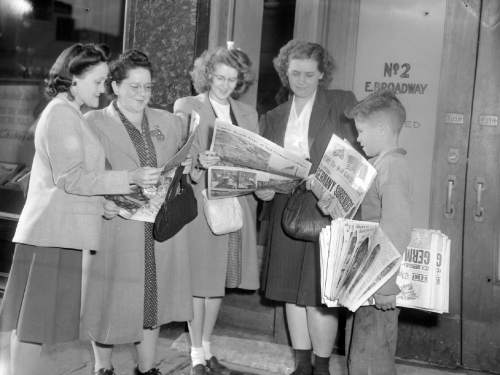This is an archived article that was published on sltrib.com in 2016, and information in the article may be outdated. It is provided only for personal research purposes and may not be reprinted.
Before I became a reporter, my closest ties to the romance of Utah's newspaper history were my father's stories of delivering papers in his East Millcreek neighborhood during the late 1930s.
In more recent years, contemporary generations have discovered newspaper history through Disney's "Newsies," a 1992 film adapted into a 2012 Broadway musical, now with a national tour that hit Salt Lake City on Tuesday. The musical, anchored by high-energy production numbers, details the unlikely story of orphan newsboys who, in 1899, faced off against newspaper tycoons in a ragtag strike and earned a rare victory.
That New York City labor battle might have inspired songs, but newsies across the country have their own colorful chapters.
Salt Lake City newsy history offers a twist on the price war that sparked the New York labor battle. In the 1890s, Utah newsboys formed their own union, ganging up to boycott the Salt Lake Telegram.
The Telegram angered its sellers because the paper charged 3 cents, in contrast to the nickel charged by the Deseret News. The problem? Newsies didn't have pennies to make change.
"Unless a customer presented three pennies in exact change, he would usually wind up paying a nickel or going without his paper," according to William John Gilbert Gould in his 1995 memoir, "My Life on Mountain Railroads," as referenced by historian Kent Powell in a March 1996 History Blazer column.
"The management of the paper soon got wise and started to clamp down on us," Gould wrote. "They refused to let us have papers unless we could show that we had a handful of pennies with which to make change. I think this rule was what caused us to organize the union. We boycotted the Telegram. If any kid showed up on the street with those papers, he had them taken away and torn to pieces by the goon squad. After a few days of this, the Telegram changed its advertised price to 5 cents a copy."
Other historical accounts suggest the competitive nature of the newsboys, usually impoverished youths from 6 to 10 years old, in the early 1900s. Young boys, such as Charles "Chick" McGillis, staked claims to street corners with their fists. McGillis was dubbed "the fighting newsboy of Salt Lake," and his windmill swing later propelled him to an amateur fighting career, according to a 2006 Tribune Living History column written by Eileen Hallet Stone.
Stone learned the outlines of McGillis' story from his son Richard, then 85. McGillis was also noted for his marketing ingenuity, thanks to his slogan: "If you've got a home, I have your home paper."
In 1910, he built a news box on wheels that The Tribune labeled "the most complete street newspaper stand built." It was a "10-by-6 red-bodied, black-trimmed store on yellow rims [that] secured its corner on 200 South and State. It collapsed into a box by night and opened each morning into an elaborate magazine stand replete with wooden display panels, counters, benches and an electric sign reminding everyone to 'Read The Salt Lake Tribune,' " Stone wrote.
The column outlined the work of financier Russel L. Tracy, who for nearly three decades led efforts to help poor newsboys. Tracy hosted a series of dinners for the young workers, continuing his efforts after one outing for 75 rowdy newsies at Bond's Restaurant turned into a food fight. "The boy who instigated the food fight? That was Herbert B. Maw, the Democratic governor of Utah from 1941 to 1949," Stone writes.
Tracy's group provided food, clothing and sacks of coal, as well as monetary incentives to help the boys stay in school. Eventually, his group built a gym that sponsored monthly wrestling and boxing matches, as well as canyon summer camps.
Other mentions of Utah newsies from period newspapers report on annual outings to Saltair resort, punctuated by youthful high jinks that usually included fistfights. One short in the Salt Lake Herald, published July 30, 1902, recounts how the boys "went out and had a merry time." Many of their "mothers went along to see that the boys didn't get strangled in the water," the paper reported.
Another short, published in the Herald on Nov. 24, 1916, recounts a proposal by the city's hotel association to ban newsboys from "crying their wares" from 9 p.m. to 9 a.m., as hotel guests are "considerably disturbed by their shouting."
The Fair Labor Standards Act of 1938 upheld child labor reform, writes Stone, adding that "by 1941, the newsies were no more." —
'Newsies'
The Disney musical is sold out for its first Capitol Theatre run, Tuesday through June 12. The national tour will return to play another run in Salt Lake City on Aug. 25-28. Tickets, $45-$85, are available at artsaltlake.org. More information at broadway-at-the-eccles.com/newsies-return.
More • Got more stories of Utah newsies and early labor unions — including stories of newsies who played hooky for orphan's day at Salt Air? Send accounts to ellenf@sltrib.com (subject line: "SLnewsies") to be included in posts on The Salt Lake Tribune's Facebook page during the June and August runs of "Newsies."







